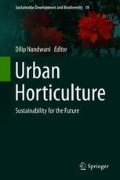Abstract
Edible landscaping is simply a way of using veggies, herbs, fruits, and flowers that will perform multiple functions, such as for food, flavor, and ornamental appearance. Edible landscaping offers an alternative to conventional landscapes producing vegetables , fruits, and herbs for home use. Edibles can be independently grown or blend with ornamentals into existing yards and gardens into aesthetically pleasing designs. Many edibles function in landscape in just a perfect way, i.e., date palm is extensively used in landscape as a major tree, rosemary that is used as spice is a suitable for low-growing perennial hedge, and purple basil is perfect alternative for dark-leaved annuals for pots. The need for edible landscaping is gaining more interest due to the increasing of population and spreading of urban communities worldwide as it functions many goals leading us to explain the benefits and methods of applying edible ornamentals or as preferred to be titled as edible landscaping.
Access this chapter
Tax calculation will be finalised at checkout
Purchases are for personal use only
References
Beck TB, Quigley MF (2003) Emergy evaluation of food productioin in urban residential landscapes. Urban Ecosyst 5(3):187–207
Bhatt V, Farah LM (2009) Designing edible landscapes. Open House Int 34:5–7
Bohn K, Viljoen A (2005) More space with less space: an urban design strategy. In: Viljoen A (ed) CPULS: continuous productive urban landscapes—designing urban agriculture for sustainable cities. Elsevier, Amsterdam, The Netherlands, pp 11–16
Deelstra T, Girardet H (2000) Urban agriculture and sustainable cities. In: Bakker N, Dubbeling M, Gundel S, Sabel-Koschela U, de Zeeuw H (eds) Growing cities, growing food: urban agriculture on the policy agenday. Deutsche Stiftung fur Internationale Entwicklung (DSE): Feldafing, Germany, pp 43–65
Dubbeling M, Bracalenti L, Lagorio L (2009) Participatory design of public spaces for urban agriculture, Rosario, Argentina. Open House Int 34:36–49
East AJ, Dawes LA (2009) Home gardening as a panacea: a case study of South Tarawa. Asia Pac. View. 50:338–352
Halweil B (2002) Home grown: the case for local food in a global market. World watch Institute, Danvers, MA
Henderson CL (1987) Landscaping for wildlife. Minnesota Dept. of Natural Resources, St. Paul, MN
Holmer RJ, Drescher AW (2009). Allotment gardens of Cagayan de Oro: their contribution to food security and urban environmental management. In: Knie C (ed) Urban and peri-urban developments—structures, processes and solutions. Southeast Asian-German Summer School Program, Cologne, Germany, pp 149–155
Koont S (2009) The urban agriculture of Havana. Mon Rev 60:44–63
Lovell ST (2010) Multifunctional urban agriculture for sustainable land use planning in the united states sustainability 2:2499–2522. https://doi.org/10.3390/su2082499
Midmore DJ, Jansen HGP (2003) Supplying vegetables to Asian cities: is there a case for peri-urban production? Food Policy 28:13–27
Parmer SM, Salisbury-Glennon J, Shannon D, Struempler B (2009) School gardens: an experiential learning approach for a nutrition education program to increase fruit and vegetable knowledge, preference, and consumption among second-grade students. J Nutr Educ Behav 41:212–217
United Nations Future World Population Growth to be Concentrated in Urban Areas of World According to New Report Issued by United Nations Population Division POP/815 21 March 2002 Retrieved from http://www.un.org/esa/population/publications/wup2001/WUP2001pressrelease.pdf
Vitiello D (2008). Growing edible cities. In: Birch EL, Wachter SM (eds) Growing greener cities. University of Pennsylvania Press, Philadelphia, PA, USA
Wakefield S, Yeudall F, Taron C, Reynolds J, Skinner A (2007) Growing urban health: community gardening in South-East Toronto. Health Promot Int 22:92–101
Author information
Authors and Affiliations
Corresponding author
Editor information
Editors and Affiliations
Rights and permissions
Copyright information
© 2018 Springer International Publishing AG, part of Springer Nature
About this chapter
Cite this chapter
Fetouh, M.I. (2018). Edible Landscaping in Urban Horticulture. In: Nandwani, D. (eds) Urban Horticulture. Sustainable Development and Biodiversity, vol 18. Springer, Cham. https://doi.org/10.1007/978-3-319-67017-1_7
Download citation
DOI: https://doi.org/10.1007/978-3-319-67017-1_7
Published:
Publisher Name: Springer, Cham
Print ISBN: 978-3-319-67016-4
Online ISBN: 978-3-319-67017-1
eBook Packages: Biomedical and Life SciencesBiomedical and Life Sciences (R0)

